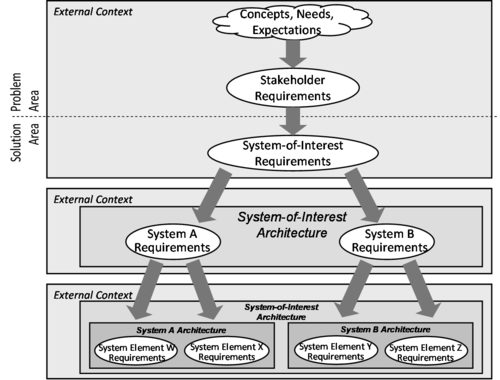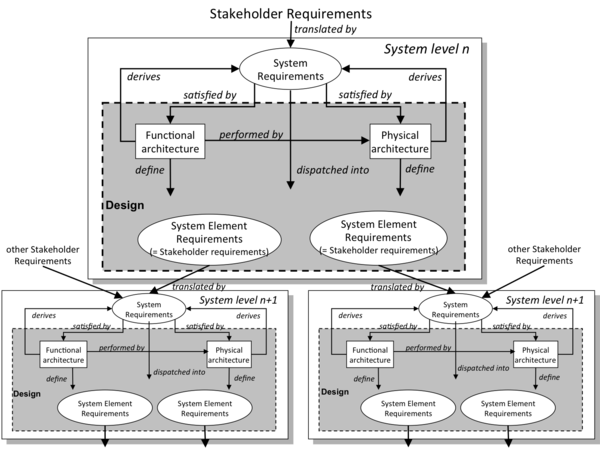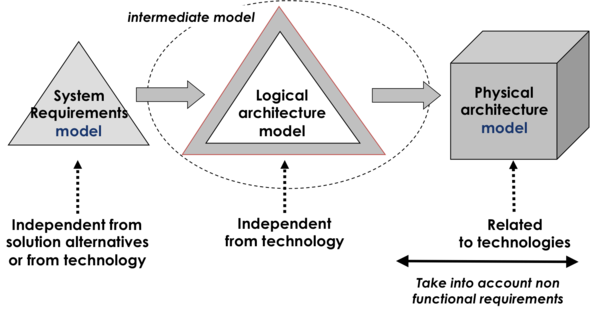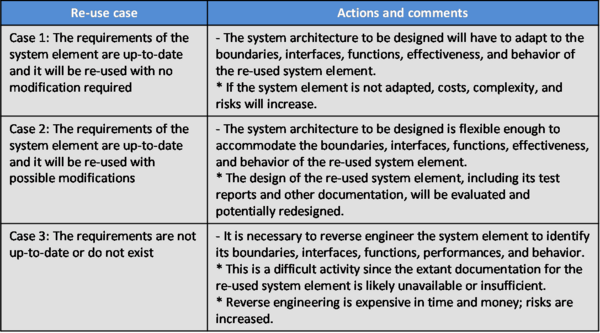System Definition
After the determination of the need for a new or modified system, System Definition activities are conducted to describe the system in detail. The activities are grouped and described as generic processes that are performed iteratively and/or concurrently depending on the selected development cycle model . These consist of the definition of system requirements, design of the physical and logical system architecture, and system analysis.
System definition activities build on the artifacts and decisions from Concept Definition, primarily the articulation of the mission of the system of interest , the needs and requirements of stakeholders, and preliminary operational concepts. The products of system definition activities (system requirements, architecture , etc.) are inputs to System Realization. The specific activities and sequence of system definition activities will be dependent upon the type of life cycle model being utilized.
To download a PDF of all of Part 3 (including this knowledge area), please click here.
Topics
The topics contained within this knowledge area include:
System Views and System Elements
To engineer a system, a set of engineering elements, characteristics, and properties have to be defined. These elements can be grouped in several views as follows.
Needs and Requirements view - Following characteristics provide a global understanding of the system in its context of use and seen as a black box.
- The Purpose states the relevance of the system within the context of use.
- The Mission expresses the set of services the system provides, the main and global transformation it performs, and how it fulfills a capability or need for the enterprise.
- The objectives are elements that quantify the mission, as a set of measurable data related to space, time and effectiveness.
- The expression of the mission is generally an abstraction of a set of actions performed by the system within its context of use and under operational conditions. This set of actions is called operational scenario and describes how these actions are related to each other and what they exchange with the elements of the context.
All these elements are refined iteratively until a comprehensive view of the system within its context is obtained. They are used to elicit needs, to define Stakeholder Requirements, and then System Requirements.
Architectures view - There are two complementary architectural representations of the system:
- The Logical Architecture supports the logical operation of the system all along its life cycle, and includes as a minimum Functional, Behavioral and Temporal views. Operational Scenarios refine the mission into a collection of Functions and dynamic structures that describe how mission is performed.
- The Physical Architecture is a set of System Elements performing Functions of the system. Those System Elements can be either material or immaterial (e.g., equipments made of hardware, software and/or human roles).
These architectures are mapped onto each other. The interactions between system elements are defined by interfaces whose complexity strongly depends on the way these architectures are designed.
Boundary and interface view - Boundary of the system depends on what engineers include within the scope of the system and outside of it. This view encompasses:
- Input-Output Flows exchanged between the system and elements of its context of use (functional interface),
- Physical Interfaces (physical connections) that support these exchanges.
Interactions are modelled and defined using Operational Scenarios.
System breakdown view – Facing the potential number of system elements that constitute the physical architecture, sets of system elements can be grouped to form systems. So, the decomposition of the system of interest (soi) (highest level) may include several layers of systems (intermediate levels of systems) until technological system elements (lowest level) are defined.
Because a System Element is primarily a system, it can be characterized in its turn using the previous views in its own context. The notion of system as described and defined here is recursive.
Other views of a system are possible to describe a more complete set of characteristics – refer to Architectural Frameworks (DoDAF, MODAF, NAF, etc.).
Top-down and recursive approach to system decomposition
System Definition is managed through methodical top-down decomposition of the SoI into systems and system elements. As the design process advances, emerging systems and system elements form a System Breakdown Structure (SBS). For project management purpose, every system of the SBS may be included in a "building block", a notion introduced in (ANSI/EIA. 1998).
Stakeholder Requirements and System Requirements exist at all layers of the SBS. In (ISO/IEC. 2011), these layers are known as levels of abstraction. As well as systematically introducing layers of design, the design process manages transformation of System Requirements through levels of abstraction.
Figure 1 portrays this approach.
- The white ovals represent requirements at decreasing levels of abstraction, and the arrows represent the transformation of those requirements through the levels. Stakeholder expressions of needs, expectations, and constraints are transformed into stakeholder requirements.
- The next transformation crosses the boundary between the problem and solution areas by converting Stakeholder Requirements into System Requirements, reflecting the bounded solution space.
- At the SoI level, the system architecture is developed that serves to identify systems and system elements, and how they operate together to address the SoI requirements.
This approach is applied recursively for each level of the system recognizing that the same generic processes are applied at multiple levels of abstraction. Figure 2 below portrays the engineering that occurs in each system block.
As necessary, system elements are defined through sets of system element requirements. These lower-level requirements act as stakeholder requirements as they become inputs to other system blocks (level n+1).
The approach is then recursively applied through the system definition process.
At level n + 1, the systems or system elements may also collect other stakeholder requirements that are directly pertinent to this level of design. Processes within each system are generic, but unique in local purpose, scope and context.
Different understandings of “requirements”
To avoid confusion in the multitude of terms around requirement consider the following classifications:
- Process role or state: The role the requirement plays in the Definition process; for instance, its position in the system block: translated, derived, satisfied; or its state of agreement: Proposed, Approved, Cancelled.
- Level of abstraction: The level within the Definition process for the requirement stands; for instance, Stakeholder Requirement, System Requirement, System Element Requirement.
- Type of requirement: The nature of the requirement itself; for instance Functional, Performance, Constraint.
Any single requirement may simultaneously be in a particular state, at a particular level abstraction, and of a particular type.
For additional explanations about differences between stakeholder, user, and customer, and between kinds of requirements, refer to (Martin, J. N. 1997) chapter 2.
System Architecture
Within the Systems Engineering community, notions of architecture seem to have been heavily influenced by ISO/IEC 15288, which even today presents a somewhat implicit view of architecture, conflating it with design as part of a single process step called “Architectural Design”. Although there are diverse viewpoints on architecture, the different perspectives have much in common. We consider systems engineering to cover all aspects of the creation of a system, including system architecture.
Definitions
See the entry architecture .
Some Common Concepts
The majority of interpretations of system architecture are based on the fairly intangible notion of structure – i.e. relationships between elements.
Some authors limit the types of structure considered to be architectural, say for example restricting themselves to functional and physical structure. Recent practice has extended consideration to include temporal and other dimensions of structure within specified architectural frameworks (e.g DODAF, MODAF) – refer to (DODAF, 2010) and (MODAF, 2010).
ISO/IEC/IEEE 42010 provides a useful description of the architecture considering the stakeholder concerns, architecture viewpoints, architecture views, architecture models, architecture descriptions, and architecting in the life cycle. A discussion of the features of systems architectures can be found in (Maier, M., and E. Rechtin. 2009).
While architectural concepts are very useful and widely used in Systems Engineering, there is a lack of consistency across communities of practice with potential for confusion. An attempt to develop and apply a systematic approach to characterizing architecture "Belief Systems" in Systems Engineering has been described by the INCOSE UK Architecture Working Group – refer to (Wilkinson et al. 2010) and (Wilkinson 2010).
System design
Principles, rules, heuristics
Engineers and architects often use heuristics learned from experience. When an issue is identified through system requirements, heuristics may be able to address the issue. Principles, rules, heuristics that govern systems can be classified as:
- Static domain relates to physical design, in other words, physical structure or organization of the System of Interest, which is broken into systems and System Elements. It deals with partitioning systems, system elements, and physical interfaces between system elements.
- Dynamic domain relates to logical design, in particular to the behavior of the system. It includes a description of functions (i.e. transformations of Input/Output Flows) and interactions between functions of the system and between those of the external objects or systems. It takes into account reactions to events that launch or stop the execution of functions of the system. It deals also with effectiveness (performances, operational conditions) of the system.
- Temporal domain concerns temporal invariance levels of the execution of functions of the system. This means that every function is executed according to cyclic or synchronous characteristics. It includes also decisional levels that are asynchronous characteristics of the behavior of some functions.
- Environmental domain relates to enablers (Production, Logistics Support, etc.), but also to survivability of the system in reaction to natural hazards or threats, and to integrity of the system in reaction to internal potential hazards. This includes, for example, climatic, mechanical, electromagnetic, and biological aspects.
More detailed classification can be found in (Maier and Rechtin 2009).
Transition from System Requirements to Physical Architecture
The aim of the approach is to progress from system requirements (representing the problem from a supplier/designer point of view, as much as possible independent of technology) to an intermediate model of logical architecture , then to allocate the elements of the logical architecture to elements of potential Physical Architectures. Design decisions and technological solutions are selected according to performance criteria and non-functional requirements such as operational conditions and life cycle constraints (e.g., environmental conditions, maintenance constraints, realization constraints, etc.) – see Figure 4.
Iterations between Logical and Physical Architecture Design
Design activities require spending several iterations from logical design to physical design and vice versa until both logical and physical architectures are exhaustive and consistent. The first design activity is the creation of a logical architecture based on nominal scenarios (of functions). Physical design then enables to determine main system elements that could perform system Functions and to organize them into a physical architecture.
A second logical design loop allows taking into account allocations of functions to system elements and derived functions coming from physical solution choices, as well as supplementing the initial logical model by introducing other scenarios, failure analyses, and every operational requirement not taken before. Derived Functions must, in their turn, be allocated to system elements, and this, in turn, affects physical design.
Other design loops must be considered to produce an exhaustive and consistent logical and physical solution. During design, technological choices lead potentially to new functions, new input/output and control flows, and new physical interfaces. These new elements can conduct to creation of new system requirements, called “derived requirements”.
Concept of interface
The concept of interface is one of the most important to consider when defining the architecture of a system. The fundamental aspect of an interface is functional and is defined as inputs and outputs of functions. As functions are performed by physical elements, inputs/outputs of functions are also carried by physical elements, called Physical Interfaces. Consequentially, both functional and physical aspects are considered in the notion of interface. A detailed analysis of an interface shows the function “send,” located in one system element, the function “receive,” located in the other one, and the function “carry,” performed by the physical interface which supports the input/output flow – see Figure 5.
In the context of complex exchanges between system elements (IT systems), a protocol is seen as a physical interface that carries exchanges of data.
Re-use of System Elements
Systems frequently incorporate existing system elements. This re-use constraint has to be identified as a system requirement and carefully taken into account during design. One can distinguish three general cases when re-using system elements. Table 1.
Re-use may introduce risks that can be significant for the project (costs, deadlines, complexity). Disappointment can be severe because of the widespread false idea that re-use is free.
References
Works Cited
ANSI/IEEE. 2000. Recommended Practice for Architectural Description for Software-Intensive Systems. New York, NY, USA: American National Standards Institute (ANSI)/Institute of Electrical and Electronics Engineers (IEEE), ANSI/IEEE 1471-2000.
ANSI/EIA. 1998. Processes for Engineering a System. Philadelphia, PA, USA: American National Standards Institute (ANSI)/Electronic Industries Association (EIA), ANSI/EIA-632-1998.
DOD. 2010. “DOD Architecture Framework.” Version 2.02. Arlington, VA, USA: US Department of Defense. Available at: http://cio-nii.defense.gov/sites/dodaf20/
Faisandier, A. 2011 (unpublished). Engineering and Architecting Multidisciplinary Systems.
INCOSE. 2010. INCOSE Systems Engineering Handbook. Version 3.2. San Diego, CA, USA: International Council on Systems Engineering (INCOSE), INCOSE-TP-2003-002-03.2.
ISO/IEC/IEEE. 2011. Systems and software engineering - Requirements Engineering. Geneva, Switzerland: International Organization for Standardization (ISO)/International Electrotechnical Commission/ Institute of Electrical and Electronics Engineers (IEEE), (IEC), ISO/IEC/IEEE 29148.
ISO/IEC 2008. Systems and Software Engineering -- System Life Cycle Processes. Geneva, Switzerland: International Organisation for Standardisation / International Electrotechnical Commissions. ISO/IEC/IEEE 15288:2008 (E).
ISO/IEC/IEEE. 2011. Systems and software engineering - Architecture description. Geneva, Switzerland: International Organization for Standardization (ISO)/International Electrotechnical Commission (IEC)/Institute of Electrical and Electronics Engineers (IEEE), ISO/IEC/IEEE 42010.
Maier, M., and E. Rechtin. 2009. The Art of Systems Architecting. 3rd ed. Boca Raton, FL, USA: CRC Press.
Martin, J.N. 1997. Systems Engineering Guidebook: A Process for Developing Systems and Products. 1st ed. Boca Raton, FL, USA: CRC Press.
MOD. 2010. “MOD Architecture Framework”. Version 1.2.004. UK Ministry of Defence. Available at: http://www.mod.uk/DefenceInternet/AboutDefence/WhatWeDo/InformationManagement/MODAF/.
Stevens, R. P. Brook, K. Jackson, S. Arnold. 1998. Systems Engineering - Coping with Complexity. Englewood Cliffs, NJ, USA: Prentice-Hall.
Wilkinson, M., A. James, M. Emes, P. King, P. Bryant. 2010. “Belief Systems in Systems Architecting: Method and Preliminary Applications," paper presented at the IEEE SMC Society’s 5th International Conference on System of Systems Engineering (SoSE). 22nd-24th June 2010. Loughborough University, UK.
Wilkinson, M. K. 2010. “Z8: Systems Architecture”, in Z-guide series. INCOSE UK, available from INCOSE UK at: http://www.incoseonline.org.uk/Program_Files/Publications/zGuides.aspx?CatID=Publications
Primary References
ANSI/EIA. 1998. Processes for Engineering a System. Philadelphia, PA, USA: American National Standards Institute (ANSI)/Electronic Industries Association (EIA), ANSI/EIA 632-1998.
Blanchard, B. S., and W. J. Fabrycky. 2005. Systems Engineering and Analysis. 4th ed. Prentice-Hall International Series in Industrial and Systems Engineering. Englewood Cliffs, NJ, USA: Prentice-Hall.
INCOSE. 2011. INCOSE Systems Engineering Handbook: A Guide for System Life Cycle Processes and Activities. Version 3.2.1. San Diego, CA, USA: International Council on Systems Engineering (INCOSE), INCOSE-TP-2003-002-03.2.1.
ISO/IEC. 2007. Systems Engineering – Application and Management of The Systems Engineering Process. Geneva, Switzerland: International Organization for Standards (ISO)/International Electronical Commission (IEC), ISO/IEC 26702:2007.
ISO/IEC/IEEE. 2008. Systems and Software Engineering - System Life Cycle Processes. Geneva, Switzerland: International Organization for Standardization (ISO)/International Electronical Commission (IEC), Institute of Electrical and Electronics Engineers. ISO/IEC/IEEE 15288:2008 (E).
ISO/IEC/IEEE. 2011. Systems and Software Engineering - Requirements Engineering. Geneva, Switzerland: International Organization for Standardization (ISO)/International Electrotechnical Commission/ Institute of Electrical and Electronics Engineers (IEEE), (IEC), ISO/IEC/IEEE 29148.
ISO/IEC/IEEE. 2011. Systems and Software Engineering - Architecture Description. Geneva, Switzerland: International Organization for Standardization (ISO)/International Electrotechnical Commission (IEC)/Institute of Electrical and Electronics Engineers (IEEE), ISO/IEC/IEEE 42010.
Martin, J.N. 1997. Systems Engineering Guidebook: A process for developing systems and products. 1st ed. Boca Raton, FL, USA: CRC Press.
NASA. 2007. Systems Engineering Handbook. Washington, D.C.: National Aeronautics and Space Administration (NASA), NASA/SP-2007-6105.
Additional References
Buede, D.M. 2009. The Engineering Design of Systems: Models and Methods. 2nd ed. Hoboken, NJ, USA: John Wiley & Sons Inc.
DoD. 2010. DOD Architecture Framework. Version 2.02. Arlington, VA, USA: US Department of Defense. Available at: http://cio-nii.defense.gov/sites/dodaf20/
Faisandier, A. 2011 (unpublished). Engineering and Architecting Multidisciplinary Systems.
MOD. 2010. “MOD Architecture Framework”. Version 1.2.004. UK Ministry of Defence. Available at: http://www.mod.uk/DefenceInternet/AboutDefence/WhatWeDo/InformationManagement/MODAF/.
Stevens, R. P. Brook, K. Jackson, S. Arnold. 1998. Systems Engineering - Coping with Complexity. Englewood Cliffs, NJ, USA: Prentice-Hall.
Wilkinson, M., A. James, M. Emes, P. King, P. Bryant. 2010. “Belief Systems in Systems Architecting: Method and Preliminary Applications," paper presented at the IEEE SMC Society’s 5th International Conference on System of Systems Engineering (SoSE). 22nd-24th June 2010. Loughborough University, UK.
SEBoK Discussion
Please provide your comments and feedback on the SEBoK below. You will need to log in to DISQUS using an existing account (e.g. Yahoo, Google, Facebook, Twitter, etc.) or create a DISQUS account. Simply type your comment in the text field below and DISQUS will guide you through the login or registration steps. Feedback will be archived and used for future updates to the SEBoK. If you provided a comment that is no longer listed, that comment has been adjudicated. You can view adjudication for comments submitted prior to SEBoK v. 1.0 at SEBoK Review and Adjudication. Later comments are addressed and changes are summarized in the Letter from the Editor and Acknowledgements and Release History.
If you would like to provide edits on this article, recommend new content, or make comments on the SEBoK as a whole, please see the SEBoK Sandbox.
blog comments powered by Disqus



